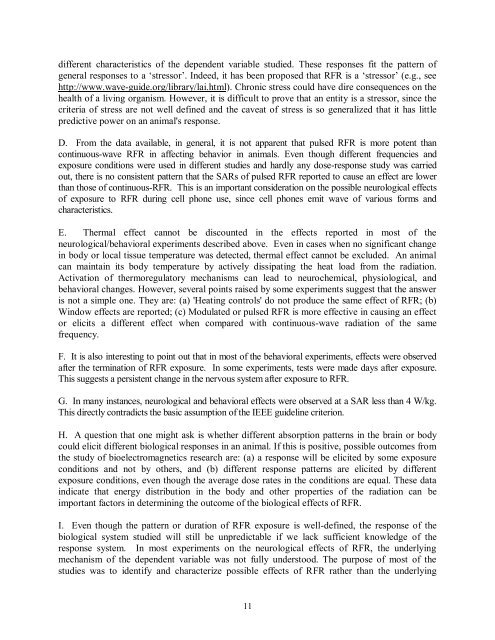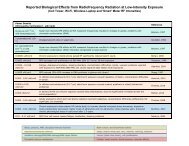Evidence for Effects on Neurology and Behavior - BioInitiative Report
Evidence for Effects on Neurology and Behavior - BioInitiative Report
Evidence for Effects on Neurology and Behavior - BioInitiative Report
Create successful ePaper yourself
Turn your PDF publications into a flip-book with our unique Google optimized e-Paper software.
different characteristics of the dependent variable studied. These resp<strong>on</strong>ses fit the pattern of<br />
general resp<strong>on</strong>ses to a ‘stressor’. Indeed, it has been proposed that RFR is a ‘stressor’ (e.g., see<br />
http://www.wave-guide.org/library/lai.html). Chr<strong>on</strong>ic stress could have dire c<strong>on</strong>sequences <strong>on</strong> the<br />
health of a living organism. However, it is difficult to prove that an entity is a stressor, since the<br />
criteria of stress are not well defined <strong>and</strong> the caveat of stress is so generalized that it has little<br />
predictive power <strong>on</strong> an animal's resp<strong>on</strong>se.<br />
D. From the data available, in general, it is not apparent that pulsed RFR is more potent than<br />
c<strong>on</strong>tinuous-wave RFR in affecting behavior in animals. Even though different frequencies <strong>and</strong><br />
exposure c<strong>on</strong>diti<strong>on</strong>s were used in different studies <strong>and</strong> hardly any dose-resp<strong>on</strong>se study was carried<br />
out, there is no c<strong>on</strong>sistent pattern that the SARs of pulsed RFR reported to cause an effect are lower<br />
than those of c<strong>on</strong>tinuous-RFR. This is an important c<strong>on</strong>siderati<strong>on</strong> <strong>on</strong> the possible neurological effects<br />
of exposure to RFR during cell ph<strong>on</strong>e use, since cell ph<strong>on</strong>es emit wave of various <str<strong>on</strong>g>for</str<strong>on</strong>g>ms <strong>and</strong><br />
characteristics.<br />
E. Thermal effect cannot be discounted in the effects reported in most of the<br />
neurological/behavioral experiments described above. Even in cases when no significant change<br />
in body or local tissue temperature was detected, thermal effect cannot be excluded. An animal<br />
can maintain its body temperature by actively dissipating the heat load from the radiati<strong>on</strong>.<br />
Activati<strong>on</strong> of thermoregulatory mechanisms can lead to neurochemical, physiological, <strong>and</strong><br />
behavioral changes. However, several points raised by some experiments suggest that the answer<br />
is not a simple <strong>on</strong>e. They are: (a) 'Heating c<strong>on</strong>trols' do not produce the same effect of RFR; (b)<br />
Window effects are reported; (c) Modulated or pulsed RFR is more effective in causing an effect<br />
or elicits a different effect when compared with c<strong>on</strong>tinuous-wave radiati<strong>on</strong> of the same<br />
frequency.<br />
F. It is also interesting to point out that in most of the behavioral experiments, effects were observed<br />
after the terminati<strong>on</strong> of RFR exposure. In some experiments, tests were made days after exposure.<br />
This suggests a persistent change in the nervous system after exposure to RFR.<br />
G. In many instances, neurological <strong>and</strong> behavioral effects were observed at a SAR less than 4 W/kg.<br />
This directly c<strong>on</strong>tradicts the basic assumpti<strong>on</strong> of the IEEE guideline criteri<strong>on</strong>.<br />
H. A questi<strong>on</strong> that <strong>on</strong>e might ask is whether different absorpti<strong>on</strong> patterns in the brain or body<br />
could elicit different biological resp<strong>on</strong>ses in an animal. If this is positive, possible outcomes from<br />
the study of bioelectromagnetics research are: (a) a resp<strong>on</strong>se will be elicited by some exposure<br />
c<strong>on</strong>diti<strong>on</strong>s <strong>and</strong> not by others, <strong>and</strong> (b) different resp<strong>on</strong>se patterns are elicited by different<br />
exposure c<strong>on</strong>diti<strong>on</strong>s, even though the average dose rates in the c<strong>on</strong>diti<strong>on</strong>s are equal. These data<br />
indicate that energy distributi<strong>on</strong> in the body <strong>and</strong> other properties of the radiati<strong>on</strong> can be<br />
important factors in determining the outcome of the biological effects of RFR.<br />
I. Even though the pattern or durati<strong>on</strong> of RFR exposure is well-defined, the resp<strong>on</strong>se of the<br />
biological system studied will still be unpredictable if we lack sufficient knowledge of the<br />
resp<strong>on</strong>se system. In most experiments <strong>on</strong> the neurological effects of RFR, the underlying<br />
mechanism of the dependent variable was not fully understood. The purpose of most of the<br />
studies was to identify <strong>and</strong> characterize possible effects of RFR rather than the underlying<br />
11



